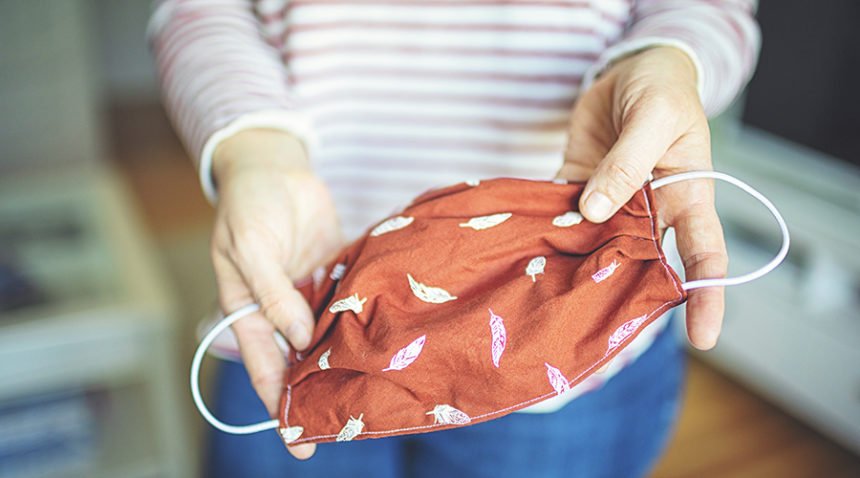Public health experts have been encouraging the use of cloth face masks and coverings in public settings to help prevent the spread of coronavirus disease 2019 (COVID-19).
Masks come in all shapes, sizes and colors—and have even become a fashion statement for some. Now that masks are a part of our daily lives, it raises the question—are all masks created equal?
UNC School of Medicine researchers recently conducted a study to find out. They studied how protective various masks and modifications are so people can make informed decisions about how best to protect themselves.
Which Masks Offer the Most Protection?
Viral exposure is not such a simple thing to study. For one, researchers can’t just go around exposing people to viral particles to see who gets COVID-19. Two, not all viral exposures are the same. Standing face-to-face unmasked with an infected person inside while eating cheese dip for an hour is not the same kind of exposure as when viral particles waft through the air and land on your hand prior to you wiping your nose.
To attempt standardizing exposure to rate mask effectiveness, UNC School of Medicine and Environmental Protection Agency scientists used an exposure chamber at the EPA research facility on the campus of UNC-Chapel Hill. This kind of chamber is where UNC and EPA environmental toxicologists study all kinds of things, such as the effects of wood smoke and ozone on people with asthma.
For COVID-19, they used the chamber to create a similar size of aerosolized particles known to carry SARS-CoV-2 viral particles. In the chamber stood Bill Bennett, PhD, who wore many different kinds of masks over the course of many experiments so his team could measure how effective each mask and modification was at filtering out the aerosolized particles.
Published in the journal JAMA Internal Medicine, the research showed that some masks were as much as 79 percent effective at blocking particles that could carry the virus. These were masks made of two layers of nylon fit snug against the wearer’s face. Unmodified medical procedure masks with ear loops—also known as surgical masks—offered 38.5 percent filtration efficacy, but when the ear loops were tied to tighten the fit, the efficacy improved to 60.3 percent. And when a layer of nylon was added, these surgical masks offered 80 percent effectiveness.
“Modifications that improve the fit of surgical masks can enhance the filtration and reduce inhalation of airborne particles,” says UNC toxicologist Phillip Clapp, PhD. “And we demonstrated that, when it comes to filtration efficiency, many consumer-grade masks were nearly equal to or better than surgical masks.”
UNC Health infection prevention expert Emily Sickbert-Bennett, PhD, says, “Limiting the amount of virus is important because the more viral particles we’re exposed to, the more likely it is we will get sick and maybe severely ill.”
Protective Improvisation
From the earliest days of the COVID-19 pandemic, crafty people everywhere began making their own face coverings. Before long, people were wearing commercial, homemade and improvised masks, all of which varied greatly in their design, material and construction.
Online, you can find a number of innovative “hacks,” devices and mask enhancements that their creators claim improve the performance of conventional masks, especially the typical surgical kind. Despite the widespread use of various masks during the pandemic, researchers had not yet evaluated how well these face coverings or mask enhancements filter airborne particles.
In the UNC study, researchers used a method based on the Occupational Safety and Health Administration Fit Test to determine the fitted filtration efficiency (FFE) of a variety of consumer-grade and improvised face masks, as well as several popular modifications of medical procedure masks. FFE refers to the ability of the mask’s material to filter out particles and the mask’s fit to the face. Both are important.
Seven consumer-grade masks and five medical procedure mask modifications were fitted on Dr. Bennett. His colleagues collected FFE measurements during a series of repeated movements of his torso, head and facial muscles, as outlined by the OSHA Quantitative Fit Testing Protocol to measure how well a mask functions when worn.
Selecting the Most Effective Mask
Based on the research, the team determined the most effective consumer-grade masks are:
- 2-layer nylon mask, ear loops, with nose bridge, washed, no insert: 79 percent
- 2-layer nylon mask, ear loops, with nose bridge, 1 insert: 74.4 percent
- 2-layer nylon mask, ear loops, with aluminum nose bridge: 56.7 percent
- Cotton bandana – folded Surgeon General style: 50 percent
- Cotton bandana – folded “Bandit” style: 49 percent
- 2-layer nylon mask, ear loops, without aluminum nose bridge: 44.7 percent
- Single-layer polyester/nylon mask with ties: 39.7 percent
- Single-layer polyester gaiter/neck cover (balaclava bandana): 37.8 percent
- Polypropylene mask with fixed ear loops: 28.6 percent
- 3-layer cotton mask with ear loops: 26.5 percent
The most effective medical face masks and modifications were:
- 3M 9210 NIOSH-approved N95 Respirator: 98 percent
- Procedure mask with ear loops + “nylon hosiery sleeve”: 80.2 percent
- Procedure mask with ear loops + “Fix-the-Mask (3 rubber bands)”: 78.2 percent
- Surgical mask with ties: 71.4 percent
- Procedure mask with ear loops + “23 mm claw hair clip”: 64.8 percent
- Procedure mask with ear loops + “Ear Guard”: 61.7 percent
- Procedure mask with ear loops + “loops tied and corners tucked in”: 60.3 percent
- Procedure mask with ear loops: 38.5 percent
Click here for the latest information on the COVID-19 vaccines or visit the CDC website and the UNC Health COVID-19 Resources page, and follow UNC Health on Twitter, Facebook, Instagram and YouTube.
Photo credit: © Rike – gettyimages.com

